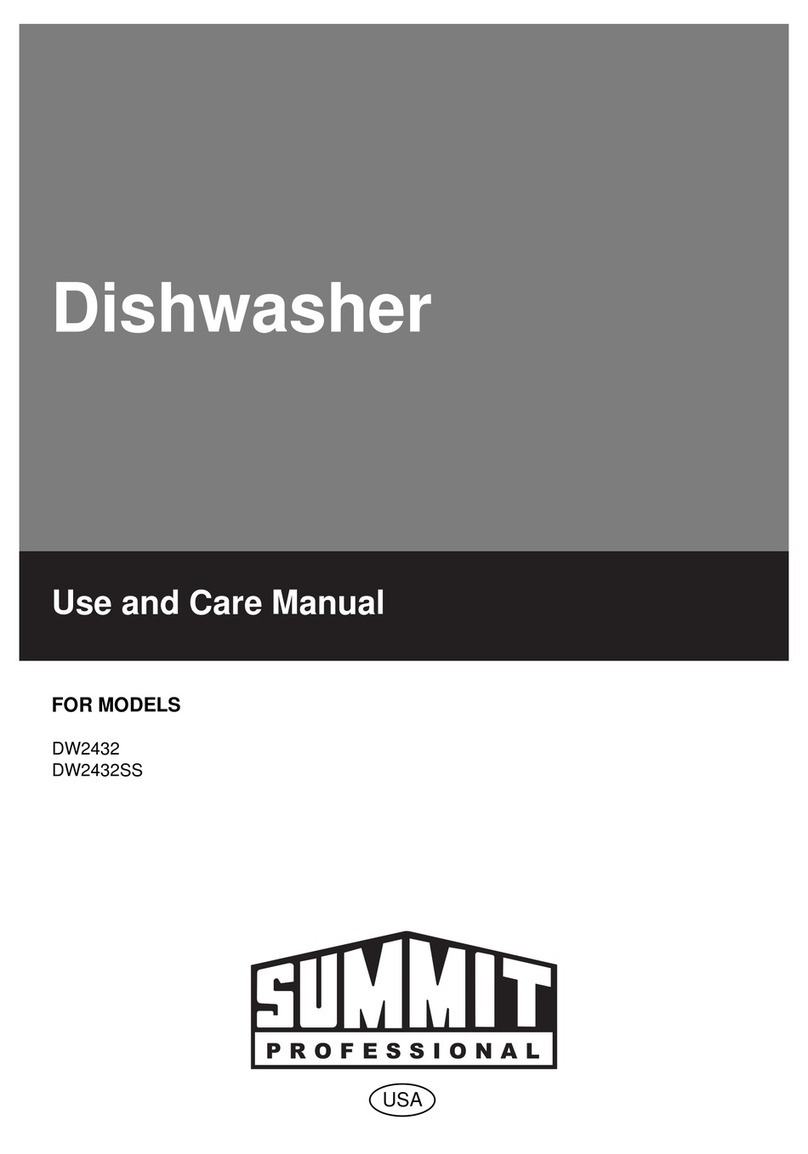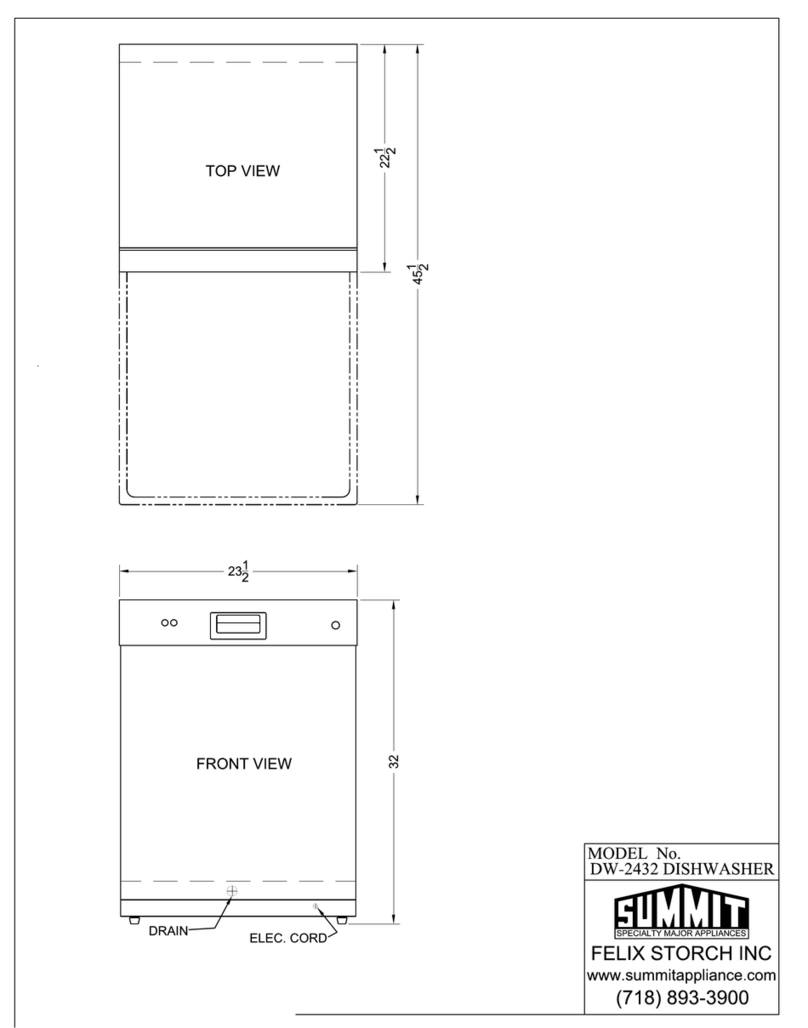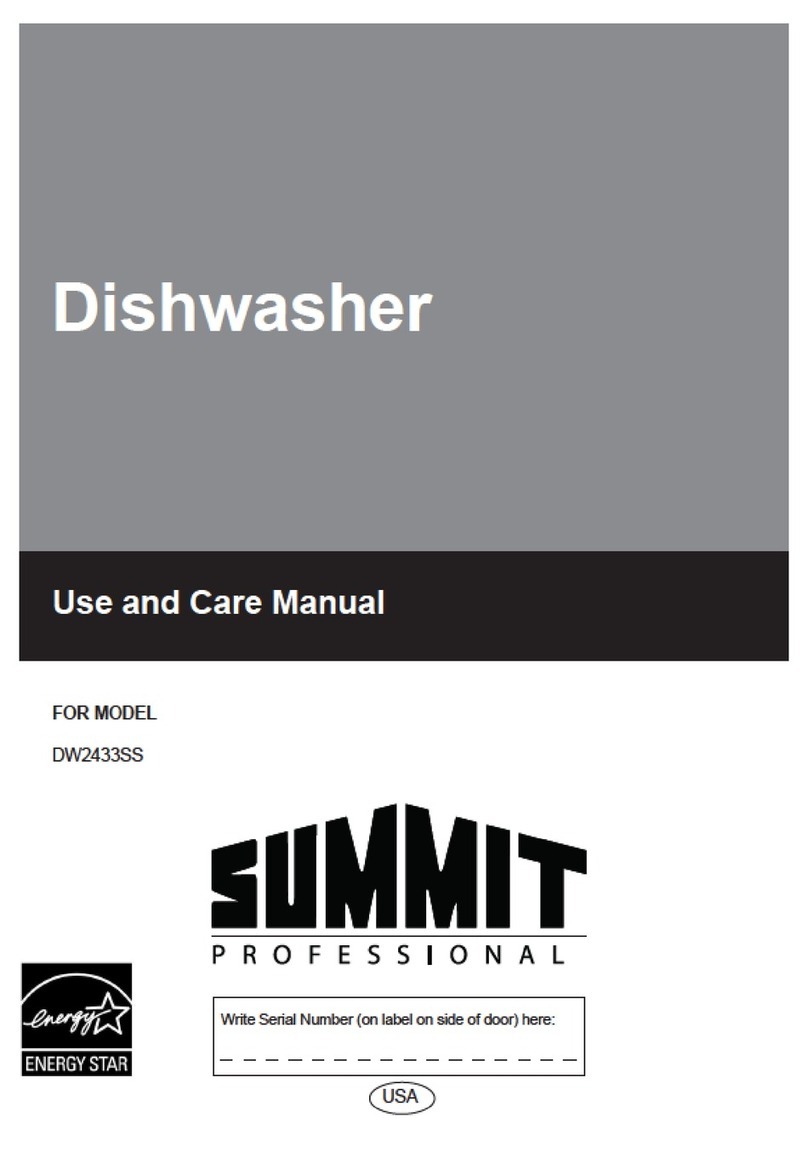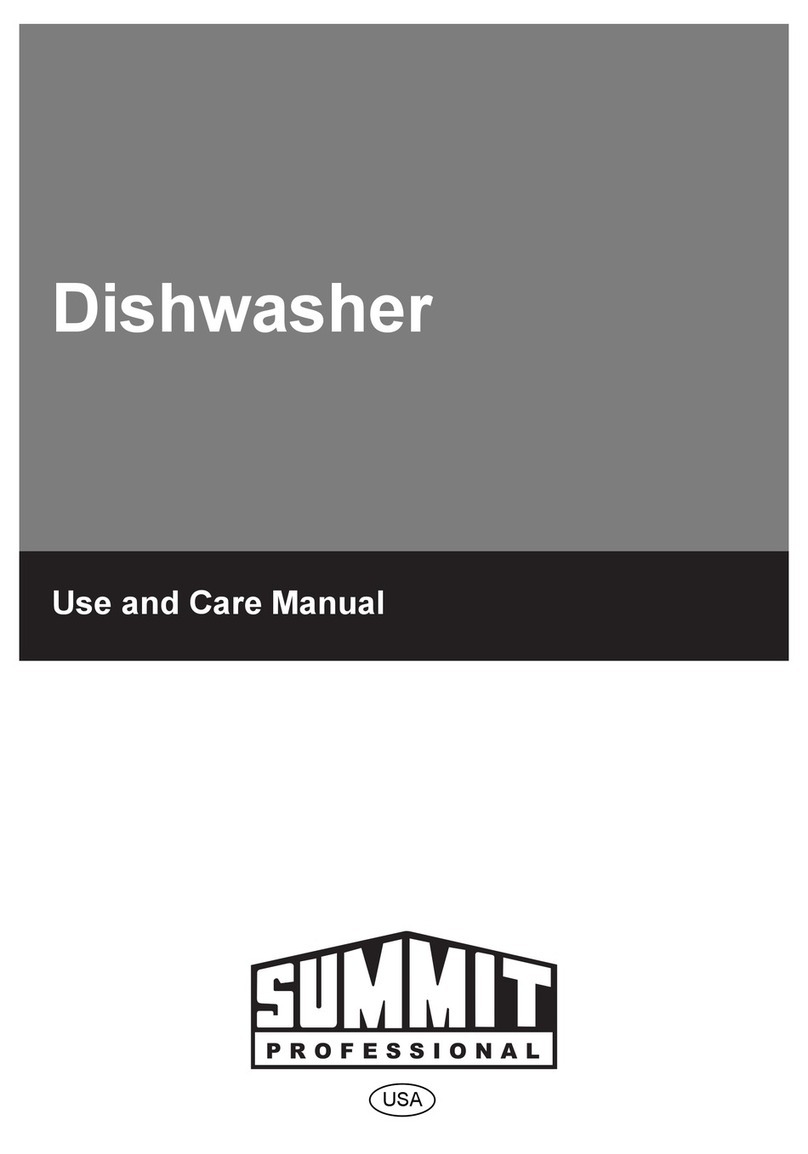Summit DW-2432 User manual

0
DISHWASHER
Models DW2432 and DW2432SS
Use & Care Manual
Felix Storch, Inc.
Summit Appliance Division
770 Garrison Avenue
Bronx, New York 10474
www.summitappliance.com
Write Serial Number (on inner door of unit) here:
_______________________________________

1
Contents
1. IMPORTANT SAFETY INSTRUCTIONS 1
2. INSTALLATION 3
3. GETTING TO KNOW YOUR DISHWASHER 4
4. LOADING THE DISHWASHER 5
4.1 UPPER RACK 6
4.2 LOWER RACK 7
4.3 PROPER AND IMPROPER LOADING OF DISHWARE 10
5. WHAT SHOULD NOT BE WASHED IN YOUR DISHWASHER 11
6. OPERATING THE DISHWASHER 12
7. DETERGENT & RINSE AID DISPENSER 14
7.1 FILLING THE DETERGENT DISPENSER 14
7.2 FILLING RINSE AID DISPENSER 15
8. SETTING THE WATER SOFTENER 17
9. FILLING THE DISHWASHER SALT DISPENSER 18
10. CARE AND MAINTENANCE 19
10.1 CARING FOR YOUR DISHWASHER EXTERIOR 19
10.2 CARING FOR YOUR DISHWASHER INTERIOR 19
11. TROUBLESHOOTING 21
12. TECHNICAL FEATURES 27
13. LIMITED WARRANTY 28
To prevent accidents which could cause serious injury or death, as well as
machine damage, read these instructions before installation and / or use:

1
INTRODUCTION
Please read this user manual and particularly
the safety instructions completely and carefully.
They will save you time and effort and help to
ensure optimum dishwasher performance.
Be sure to observe all listed warnings and
cautions. Look particularly for the icons with
exclamation marks inside. The information icon
will also provide important references.
WARNING:
Indicates a potentially hazardous situation
which, if not avoided, could result in death or
serious injury.
CAUTION:
Indicates a potentially hazardous situation
which, if not avoided, may result in injury. It may
also be used to alert against unsafe practices.
Notice:
Indicates a potentially hazardous situation
which, if not avoided, may result in damage to
the dishwasher, the tableware, the equipment or
the environment.
1. IMPORTANT SAFETY
INSTRUCTIONS
WARNING
When using the dishwasher, follow basic
precautions, including the following:
Read all instructions before using the
dishwasher! Save these operating
instructions and pass them on to any future
user.
•Use the dishwasher only for its intended
purpose as described in this user manual.
This appliance is intended for normal
household use only.
•The manufacturer disclaims responsibility
for damage or injury caused by improper
use of this appliance.
•The information in this user manual must be
followed to minimize the risk of fire or
explosion and to prevent property damage,
personal injury or loss of life.
•Do not operate your dishwasher unless all the
enclosure panels are properly in place.
•Do not tamper with the controls.
•Do not abuse, sit on, stand in or on the door
or dish rack of the dishwasher.
•The cup racks are designed to support cups,
glasses and kitchen utensils. When the cup
racks are in the dishwasher, do not lean on or
use the cup racks to support your body
weight.
•To reduce the risk of injury, do not allow
children to play in, on or near the dishwasher.
•Use only detergents or rinse aids
recommended for use in a household
dishwasher and keep them in a dry place out
of the reach of children. Check that the
detergent dispenser is empty after the
completion of each wash program.
•Dishwasher detergents are alkaline. They can
be dangerous if inhaled or swallowed. Avoid
contact with skin and eyes and keep children
and infirm persons away from the dishwasher
when the door is opened. Consult a doctor
immediately if detergent has been swallowed
or inhaled.

2
•Do not drink water from the dishwasher!
Harmful residues could be present.
•Under certain conditions, hydrogen gas may
be produced in a hot water heater system that
has not been used for two weeks or more.
Hydrogen gas is explosive. If the hot water
system has not been used for such a period,
before using the dishwasher, turn on all hot
water taps and let the water flow from each for
several minutes. This will release any
accumulated hydrogen gas. As gas is
flammable, do not smoke or use an open
flame during this time.
•Do not store or use flammable liquids or
vapors in the area of the dishwasher.
•When loading items to be washed, position
sharp items so that they are not likely to
damage the door seal and load sharp knives
with the handles up to reduce the risk of cut-
type injuries.
•Do not wash plastic items unless they are
marked “dishwasher safe” or the equivalent.
For plastic items not so marked, check the
manufacturer’s recommendations.
•If a malfunction occurs, switch off the
appliance and turn off the water supply to the
dishwasher.
•Before cleaning or carrying out maintenance,
switch off the appliance, disconnect the power
plug and turn off the water supply.
•Repairs and technical modifications must be
carried out exclusively by a qualified
technician.
•If the dishwasher is not in use for an extended
period of time (e.g., in a vacation home), we
recommend you check that the baskets are
empty, leave the inside of the dishwasher
clean, leave the door cracked open to allow
air to circulate and turn off both the power and
water supply to the dishwasher.
SAVE THESE INSTRUCTIONS

3
2. INSTALLATION
WARNING
When installing the dishwasher, follow basic
precautions, including the following:
•The dishwasher installation must be
performed in accordance with the Installation
manual. If you did not receive an installation
manual, order it by calling 1-800-932-4267, or
you may also download it from our website at
www.summitappliance.com
•Installation, maintenance and repair should be
performed by a qualified installer. Work by
unqualified persons could be dangerous and
may void the warranty.
•Do not operate the appliance if damaged,
malfunctioning, partially disassembled or if it
has missing or broken parts.
•Before installation or service, disconnect the
power supply to the work area by unplugging
the unit, “tripping” the circuit breaker or
removing the fuse.
•Only connect the dishwasher to the power
supply when all installation and plumbing work
is complete.
•Do not install or store the dishwasher where it
can be exposed to below freezing
temperatures or exposed to weather.
•The dishwasher must be secured to adjacent
cabinetry using the brackets provided. Failure
to do this may cause damage to property or
bodily injury.
•Connect to a properly rated, protected and
sized power supply circuit to avoid electrical
overload. The dishwasher is designed for an
electrical supply of 120V (volts), 60 Hz (hertz),
AC, connected to a dishwasher-dedicated,
properly grounded electrical circuit with a fuse
or breakers rated for 15 amperes. Electrical
supply conductors shall be a minimum of #14
AWG copper wire rated at 75ºC (167ºF) or
higher. These requirements must be met to
prevent injury and machine damage. Consult
a qualified electrician if in doubt.
•Do not use any extension cord or portable
outlet device to connect the dishwasher to a
power supply.
WARNING
Danger of suffocation!
Ensure that any plastic wrappings, bags,
small pieces, etc., are disposed of safely and
kept out of the reach of children.
•Remove the door to the washing compartment
when removing an old dishwasher from
service or discarding it. Ensure that the
appliance presents no danger to children
while being stored for disposal.
•Old appliances may contain materials that can
be recycled. Please contact your local
recycling authority about the possibility of
recycling these materials.
Other manuals for DW-2432
3
This manual suits for next models
1
Table of contents
Other Summit Dishwasher manuals


























